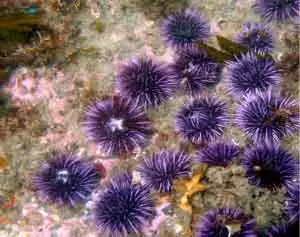Ocean Acidification: Too Much of a Good Thing?
Part C: Ocean Acidification: A Risky Shell Game?
Scientists are only beginning to do the research on how individual species of organisms might respond to increasing levels of ocean acidity as atmospheric levels of CO2 continue to rise. Will some species adapt and others not? Find out how scientists are trying to answer this question in a laboratory setting:
- Read the article Ocean Acidification: A Risky Shell Game
- Explore the interactive embedded in the article. This interactive will help you understand the chemical relationship between carbon dioxide, shell-building, H+ ions, and ocean acidification.
As you read the article and explore the interactive, make note of the types of organisms they tested and how they responded to increasing amounts of CO2. Record them in the table your teacher gives you. Your teacher may decide to assign each group specific organisms.
Checking In
- What levels of atmospheric CO2 did scientists expose the marine organisms to in their experimental design? Why did they choose these levels of atm CO2?
They exposed them to 400ppm atm CO2 (current levels), 600 ppm (predicted in a hundred years), 900 ppm (predicted in 200 years) and 2850 ppm (a very high level expected to dissolve shells).
- Why do shell-builders have to pump H+ ions out from their tissues and back into seawater?
The H+ ions like to chemically combine with carbonate ions to form bicarbonate compounds. This makes the carbonate ions unavailable to combine with calcium to produce calcium carbonate compounds, which shell-builders need to build their shells.
Stop and Think
1: From the article, choose two types of marine organisms that respond differently to increasing ocean acidification. Compare and contrast them in terms of how they responded to increasing ocean acidity.
Purple Sea Urchins. Image Source: Seagrant, UAF. Now its your turn to do some research of your own!
In Lab 5, you learned that the biological pump sequesters large amounts of carbon dioxide in food chains and in shell-building organisms that eventually die and sink to the bottom of the ocean. Could ocean acidification inhibit the ocean's ability to sequester carbon? If so, what might happen to other components of the carbon cycle? To research answers to these important questions, you will take on the role of a marine biologist!
Begin your research by reading this ScienceDaily Echinoderms Contribute to Global Carbon Sink: Impact of Sea Creatures Underestimated
Checking In
Explain how echinoderms such as starfish, sea urchins, and brittle stars contribute to the ocean carbon sink?
When echinoderms die, their calcium carbonate skeletons become buried in sediments where the carbon becomes locked up in the ocean sediments indefinitely.
Get started on your research!
Your Research Question: Could ocean acidification inhibit the ability of the oceans to sequester carbon?
Your Experimental Design:
- Sea Urchin eggs collected from off the coast of California will be raised in two different pH environments " a pH of 8.1, which represents ocean pH conditions today, and a pH of 7.7, which is predicted within the next 100 years if CO2 emissions continue to rise.
- The skeleton arms of juvenile sea urchin larva will be measured and graphed.
- Explore the sea urchin life cycle interactive and see a short video on sea urchin development created by Stanford University at VirtualUrchin Part One (more info)
- Enter the 'Acid Ocean" website by clicking on the arrow in the bottom lower right corner.
- Next, click on "cycles" in the menu at the bottom. This will take you directly to the life cycles of sea urchins interactive.
- Analyze your data
- Write a conclusion that answers the research question.
- Summarize your experiment.
- Discuss and interpret the results. Do the results provide answers to the research question?
- Would research need to be done (if any) to fully answer the research question? Why?
- Begin the experiment by entering The VirtualUrchin, The VirtualUrchin Part Two to carry out the experiment.
- Work in the Virtual Urchin Laboratory until you reach the Graphs: Interpreting Results section in part 3.
- Copy the data table, graph your data, and include with your written conclusion.
VirtualUrchin Laboratory Image Source: Stanford University
Stop and Think
2. Corals use calcium carbonate to build their hard parts. Coral reef ecosystems are very complex and are home to many different types of marine organisms. If the oceans continue to become more acidic, how might coral reef ecosystems be affected?
- Choose at least one food chain in the coral reef ecosystem in the image "hidden" below.
- Describe how increased ocean acidification could impact this food chain.
3. Scientists believe that the oceans are currently absorbing approximately one-half of the extra carbon dioxide put into the atmosphere from the burning of fossil fuels. What might happen to the carbon cycle if the ability of the oceans to absorb this extra carbon dioxide decreased over time?
- Identify one pathway in the carbon cycle that would be impacted. Be sure to include at least two reservoirs, one flux and one process in the pathway you choose. (Hint: you may want to go back to the carbon cycle interactive in Lab 2-B to help you identify a pathway)
- Describe how the "movement of carbon" and "storage of carbon" in the reservoirs, fluxes and processes might change if oceans lost the ability to absorb carbon dioxide over time. (Hint: You may want to use a diagram with notes and labels to help you with your answer)



